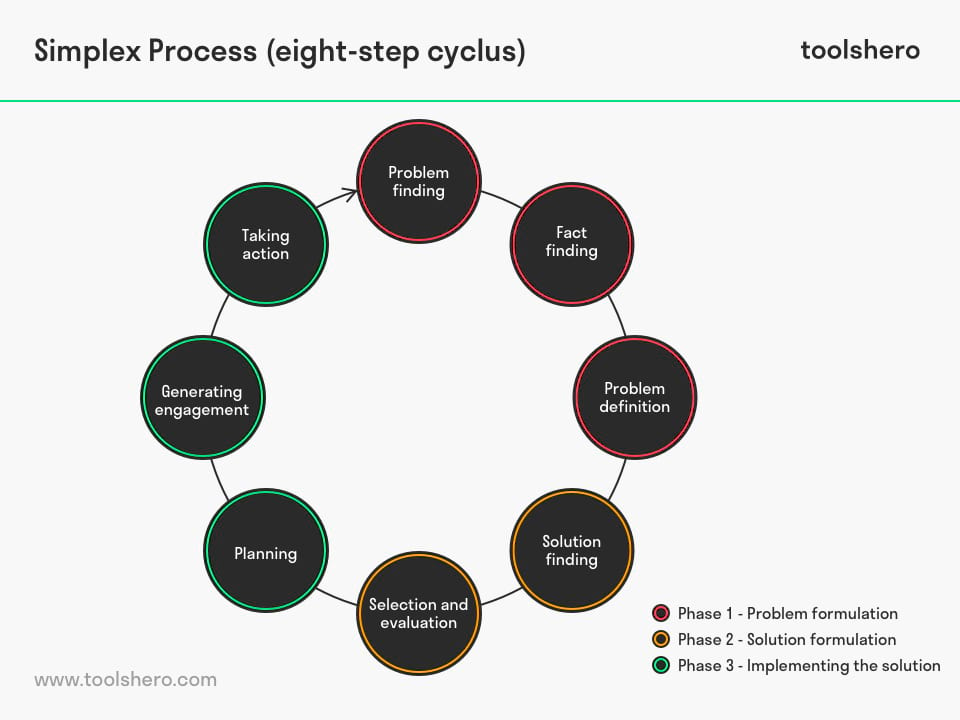Simplex Problem Solving Process

Basadur Simplex Problem Solving Process: this article provides you with a practical explanation of the Basadur Simplex Problem Solving Process. After reading, you will understand the basics of this powerful and creative problem solving method.
What is the Basadur Simplex Problem Solving Process?
Problems come in all shapes and sizes. The important thing is that they can be solved. Before acting to solve problems, however, it is very important to first identify the problem in question. Still, the most important steps in the process of problem solving are often overlooked, meaning that good solutions are not found, or even that problems are not identified correctly.
The Basadur Simplex Problem Solving Process is a problem-solving method that is aware of that, and prevents such mistakes from being made. This model was developed by the American creativity guru Marino (Min) Sidney Basadur, who presented the method in his book ‘the Power of Innovation’.
He was also the inventor of the patented Simplexity Thinking System. The Basadur Simplex Problem Solving Process works in steps during which problem-solving groups are given the opportunity to come up with creative solutions. By following the Basadur Simplex Problem Solving Process, they can diagnose the problem more easily and then suggest and implement solutions.
Basadur Simplex Problem Solving Process : three Phases
The Basadur Simplex Problem Solving Process consists of three phases, subdivided into eight steps:
Phase 1: Problem formulation
This first phase is about the first three steps of the Basadur Simplex Problem Solving Process, namely problem finding, fact finding, and problem definition. Only then can the problem be formulated correctly. When it’s clear what the problem is, you can look at where in the organisation this problem has its origins.
Phase 2: Solution formulation
After the focus on the description of the problem, the Basadur Simplex Problem Solving Process switches to the second phase of finding possible solutions. The following steps are involved; finding ideas that can lead to a solution and selecting and evaluation those ideas. This phase is about coming up with as many creative ideas as possible that might lead to solutions.
Phase 3: Implementing the solution
When the solution to a problem is close, the third and final phase follows. It contains the final three steps of the Basadur Simplex Problem Solving Process; planning all actions that need to be taken, creating support and engagement for the solution among all employees, and then take action and implement it. In this phase it’s important that the solution be prepared thoroughly. Implementing the solution should then be done in a professional manner. There also has to be room for flexibility, so the solution can be adapted if needed after implementation.
Basadur Simplex Problem Solving Process : eight Steps
Step 1: Problem finding
For this step it’s a good idea not to look for solutions right away; first the problem has to be made clear, as well as its symptoms. The cause is identified later. In this step, you look for the what customers and suppliers want and need, for instance, but employees too. Unlike many other problem-solving methods, in the Basadur Simplex Problem Solving Process the problem is not yet known when the first step is taken. Secondary questions can be used to accelerate the first step, for example:
- What tips for improvement would our customers give us?
- How would customers respond if we would communicate better?
- What is not going well in customer service right now?
Step 2: Fact finding
This step involves gathering information related to the current situation and possibly the problem. Step 1 identified the symptoms of the problem. Based on that, facts have to be gathered. What does the organisation already know about the problem in question? The gathered facts have to be assessed and evaluated. The most relevant facts will play a role in the following steps. Again, secondary questions may be helpful, such as:
- What are some of the complaints we received over the last year?
- How do customers see the problem?
- What solutions have already been attempted?
- What proposals for improvement are there?
Step 3: Problem definition
The problem area is known, so now the specific problem definition can be made. It’s important to explain the problem in a way that’s not too broad, but not too narrow either. Many ‘why’ questions help to get an idea of the bigger picture. The facts chosen can help describe the problem. The following example shows how:
- Question: ‘Why do we want to improve our customer service?’
- Answer: ‘Because customers are currently being sent back and forth between different points of contact. They want a regular contact person who knows what’s going on.’
The problem definition is about the customer service department that does not connect customers to the right person in most cases.
Step 4: Solution finding
Within the Basadur Simplex Problem Solving Process, this step is about a wide range of ideas that might offer a solution. Departments and individual employees play an important role in this. It might be a good idea to set up a project group to come up with creative solutions.
Such brainstorming sessions aren’t intended to criticise each other’s ideas. That would hamper the creative process. This step will result in a number of potential options that might solve the problem.
Step 5: Selection and evaluation
The ideas that have been obtained are now examined more closely. The goal is to decide which idea is best for solving the problem. It’s a good idea to first generate a number of evaluation criteria, allowing for an objective evaluation. The idea that meets these criteria the most is usually the best solution to the problem.
Here secondary questions can also speed up the process, for instance:
- What will be the impact of the chosen solution?
- Are there any costs associated with the chosen solution?
- How much time and effort will it take to implement the solution?
Step 6: Planning
Now that a choice has been made, it’s time for an action plan. In short that means making clear who does what, allowing everyone to work toward the solution. A small number of actions is usually enough to solve minor problems. Formal project management would be a better choice in the case of more significant problems.
Step 7: Generating engagement
It might seem superfluous, but it’s important to consider employee engagement throughout the entire process. Only when they have accepted the solution will they make an effort to bring everything to a good conclusion. Solutions to problems often involve changes. It’s usually difficult for employees to change their work habits. That’s why they have to be made aware of the negative impact of the problem and the value of the changes.
Step 8: Taking action
Only when sufficient support has been secured, can the action plan be implemented. This step deserves as much attention as the other ones; after all, if the plan is not followed, the problem won’t be solved. It’s also smart to evaluate along the way and check if the problem has become noticeably smaller.
The Basadur Simplex Problem Solving Process : cyclical process
The Basadur Simplex Problem Solving Process is a simple but powerful problem-solving model. However, it’s not a linear process; it’s a cyclical process. That means that there is room for continuous improvement.
That’s why the Basadur Simplex Problem Solving Process is often compared to Deming’s PDCA cycle; plan, do, check, act. After the final step has been completed, you should go back to the first step to further refine the problem solution.
It’s Your Turn
What do you think? Do you recognize the explanation of the simplex process? Are you familiar with the different phases and steps of this model? How do you apply the Simplex process within your organization? Do you have any tips or additions?
Share your experience and knowledge in the comments box below.
More information
- Basadur, M. (1995). The power of innovation: How to make innovation a way of life and put creative solutions to work. Financial Times Management.
- Basadur, M. (1998). The Basadur Simplex creative problem-solving profile inventory: Development, reliability and validity.
- Basadur, M. I. N., Runco, M. A., & VEGAxy, L. A. (2000). Understanding how creative thinking skills, attitudes and behaviors work together: A causal process model. The Journal of Creative Behavior, 34(2), 77-100.
How to cite this article:
Mulder, P. (2019). Basadur Simplex Problem Solving Process. Retrieved [insert date] from toolshero: https://www.toolshero.com/problem-solving/basadur-simplex-problem-solving-process/
Add a link to this page on your website:
<a href=”https://www.toolshero.com/problem-solving/basadur-simplex-problem-solving-process/”>toolshero: Basadur Simplex Problem Solving Process</a>
Published on: 25/06/2019 | Last update: 04/03/2022













